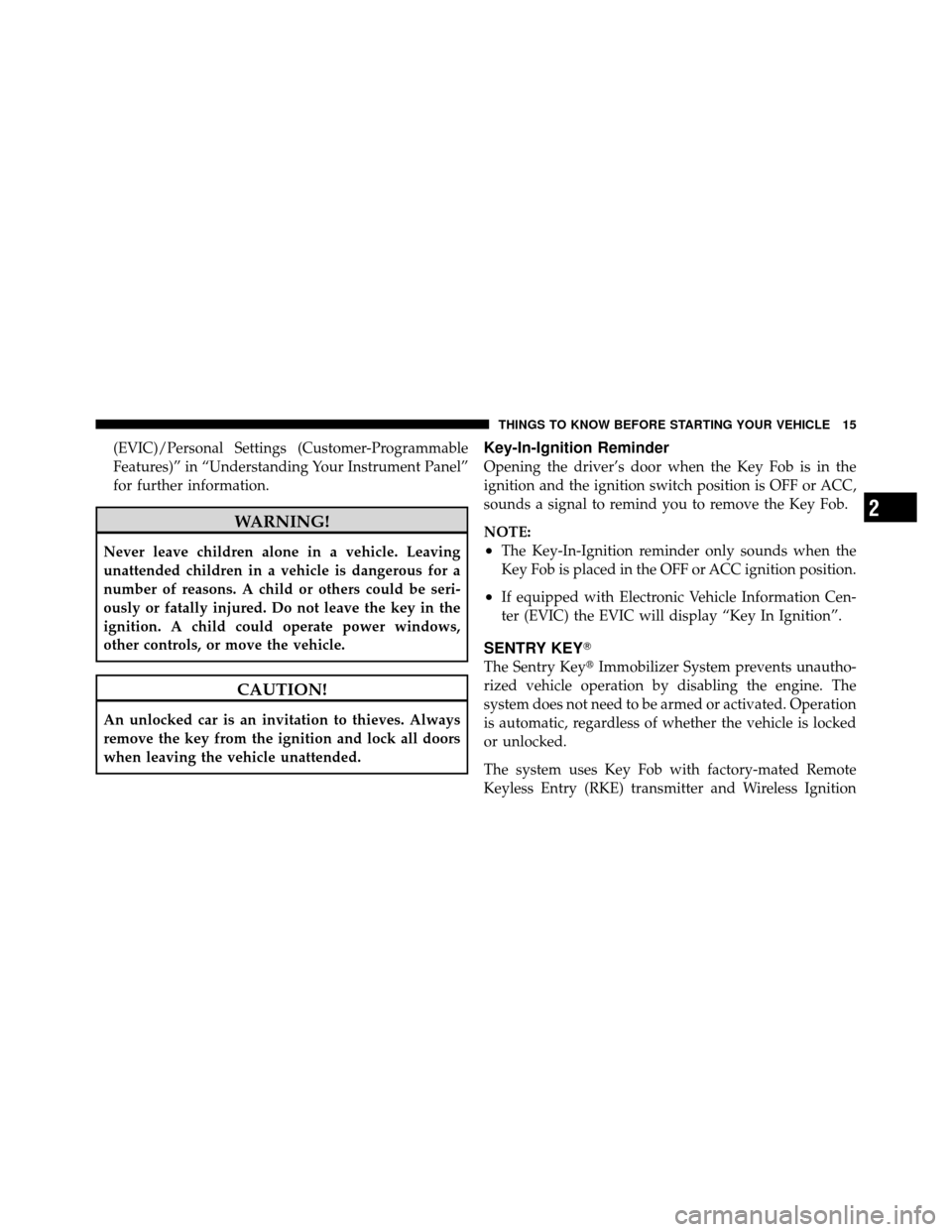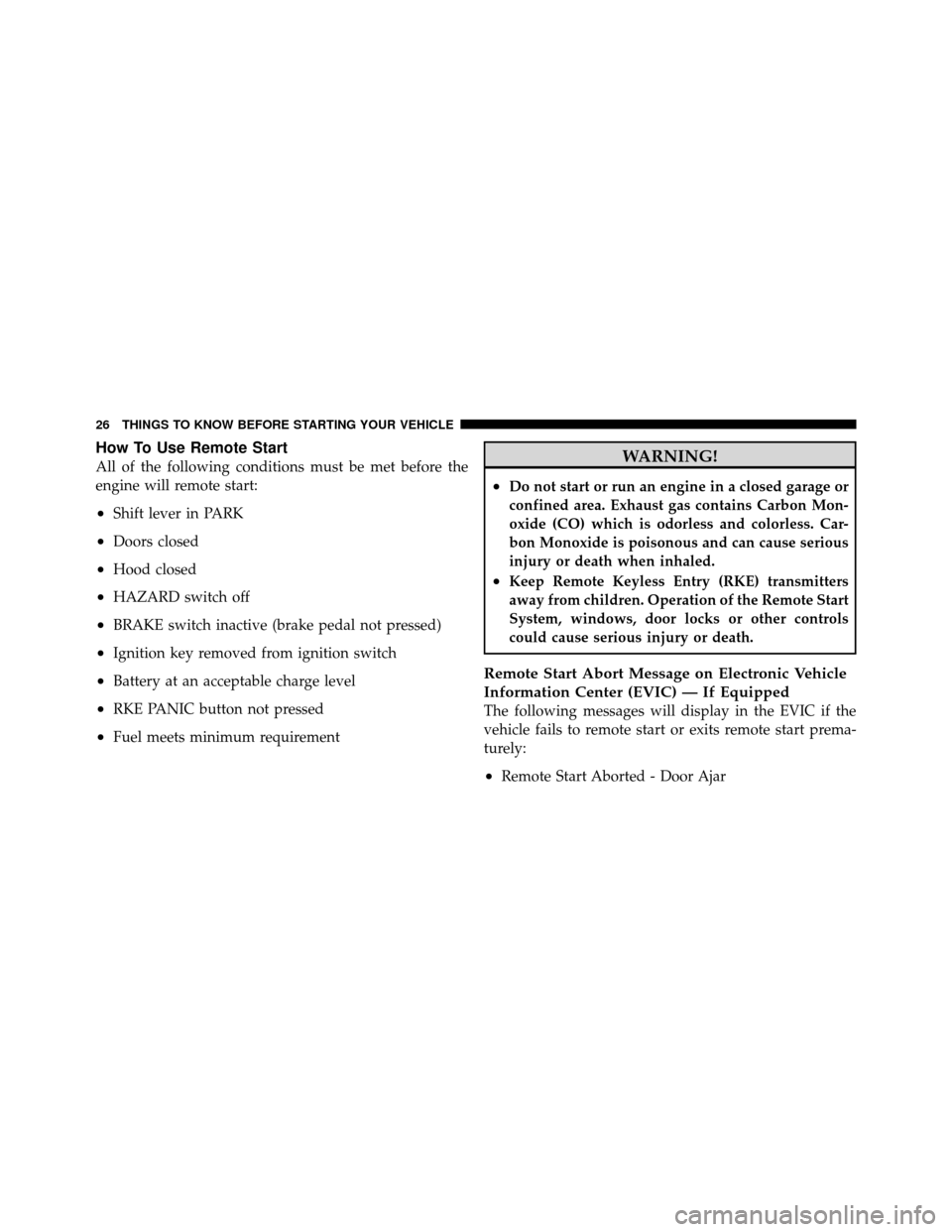Page 11 of 476

▫Remote Open Window Feature — If
Equipped ........................... 23
▫ Using The Panic Alarm ................. 24
▫ Programming Additional Transmitters ...... 24
▫ Transmitter Battery Replacement .......... 24
▫ General Information ................... 25
� Remote Starting System — If Equipped ....... 25
▫ How To Use Remote Start ............... 26
� Door Locks ........................... 28
▫ Manual Door Locks ................... 28
▫ Power Door Locks — If Equipped ......... 29
▫ Child Protection Door Lock .............. 32�
Windows ............................ 34
▫ Power Windows – If Equipped ............ 34
▫ Wind Buffeting ....................... 37
� Occupant Restraints ..................... 37
▫ Lap/Shoulder Belts .................... 38
▫ Adjustable Upper Shoulder Belt Anchorage . . . 46
▫ Center Lap Belts ...................... 47
▫ Automatic Locking Retractor (ALR) Mode –
If Equipped ......................... 47
▫ Enhanced Seat Belt Use Reminder System
(BeltAlert�) ......................... 48
▫ Seat Belts And Pregnant Women .......... 49
▫ Seat Belt Extender ..................... 49
10 THINGS TO KNOW BEFORE STARTING YOUR VEHICLE
Page 16 of 476

(EVIC)/Personal Settings (Customer-Programmable
Features)” in “Understanding Your Instrument Panel”
for further information.
WARNING!
Never leave children alone in a vehicle. Leaving
unattended children in a vehicle is dangerous for a
number of reasons. A child or others could be seri-
ously or fatally injured. Do not leave the key in the
ignition. A child could operate power windows,
other controls, or move the vehicle.
CAUTION!
An unlocked car is an invitation to thieves. Always
remove the key from the ignition and lock all doors
when leaving the vehicle unattended.
Key-In-Ignition Reminder
Opening the driver’s door when the Key Fob is in the
ignition and the ignition switch position is OFF or ACC,
sounds a signal to remind you to remove the Key Fob.
NOTE:
•The Key-In-Ignition reminder only sounds when the
Key Fob is placed in the OFF or ACC ignition position.
•If equipped with Electronic Vehicle Information Cen-
ter (EVIC) the EVIC will display “Key In Ignition”.
SENTRY KEY�
The Sentry Key�Immobilizer System prevents unautho-
rized vehicle operation by disabling the engine. The
system does not need to be armed or activated. Operation
is automatic, regardless of whether the vehicle is locked
or unlocked.
The system uses Key Fob with factory-mated Remote
Keyless Entry (RKE) transmitter and Wireless Ignition
2
THINGS TO KNOW BEFORE STARTING YOUR VEHICLE 15
Page 27 of 476

How To Use Remote Start
All of the following conditions must be met before the
engine will remote start:
•Shift lever in PARK
•Doors closed
•Hood closed
•HAZARD switch off
•BRAKE switch inactive (brake pedal not pressed)
•Ignition key removed from ignition switch
•Battery at an acceptable charge level
•RKE PANIC button not pressed
•Fuel meets minimum requirement
WARNING!
•Do not start or run an engine in a closed garage or
confined area. Exhaust gas contains Carbon Mon-
oxide (CO) which is odorless and colorless. Car-
bon Monoxide is poisonous and can cause serious
injury or death when inhaled.
•Keep Remote Keyless Entry (RKE) transmitters
away from children. Operation of the Remote Start
System, windows, door locks or other controls
could cause serious injury or death.
Remote Start Abort Message on Electronic Vehicle
Information Center (EVIC) — If Equipped
The following messages will display in the EVIC if the
vehicle fails to remote start or exits remote start prema-
turely:
•Remote Start Aborted - Door Ajar
26 THINGS TO KNOW BEFORE STARTING YOUR VEHICLE
Page 30 of 476
Front doors may be opened with the inside door handle
without lifting the lock plunger.
Doors locked before closing will remain locked when
closed.
The emergency key will unlock the driver door lock on
your vehicle.
WARNING!
•For personal security and safety in the event of an
accident, lock the vehicle doors when you drive as
well as when you park and leave the vehicle.
•Never leave children alone in a vehicle. Leaving
unattended children in a vehicle is dangerous for a
number of reasons. A child or others could be
seriously or fatally injured. Don’t leave the key in
the ignition. A child could operate power win-
dows, other controls, or move the vehicle.
Power Door Locks — If Equipped
A power door LOCK switch is on each front door trim
panel. Use this switch to lock or unlock the doors.
Power Door Lock Switch Location
1 - Unlock2 - Lock
2
THINGS TO KNOW BEFORE STARTING YOUR VEHICLE 29
Page 33 of 476
Child Protection Door Lock
To provide a safer environment for children riding in the
rear seat, the rear doors (if equipped) of your vehicle
have the child protection door lock system.To use the system, open each rear door, use a flat blade
screwdriver (or emergency key) and rotate the dial
counterclockwise to engage the lock and clockwise to
disengage the child protection locks. When the system on
a door is engaged, that door can only be opened by using
the outside door handle even if the inside door lock is in
the unlocked position.
Child Protection Door Lock Location
32 THINGS TO KNOW BEFORE STARTING YOUR VEHICLE
Page 34 of 476
WARNING!
Avoid trapping anyone in a vehicle in a collision.
Remember that the rear doors can only be opened
from the outside when the child protection locks are
engaged.NOTE:
•After setting the child protection door lock system,
always test the door from the inside to make certain it
is in the desired position.
•For emergency exit with the system engaged, move
the door lock switch to the UNLOCK position, roll
down the window and open the door with the outside
door handle.
Child Lock Control
2
THINGS TO KNOW BEFORE STARTING YOUR VEHICLE 33
Page 38 of 476

Wind Buffeting
Wind buffeting can be described as the perception of
pressure on the ears or a helicopter-type sound in the
ears. Your vehicle may exhibit wind buffeting with the
windows down or in partially open positions. This is a
normal occurrence and can be minimized. If the buffeting
occurs with the rear windows open, open the front and
rear windows together to minimize the buffeting.
OCCUPANT RESTRAINTS
Some of the most important safety features in your
vehicle are the restraint systems:
•Three-point lap and shoulder belts for the driver and
all passengers
•Advanced Front Airbags for driver and front passen-
ger — if equipped
•An energy-absorbing steering column and steering
wheel
•Knee bolsters/blockers for front seat occupants
•All seat belt systems (except driver’s, first and second
row center position) include Automatic Locking Re-
tractors (ALR)
If you will be carrying children too small for adult-sized
seat belts, the seat belts or the Lower Anchors and Tether
for CHildren (LATCH) feature also can be used to hold
infant and child restraint systems.
NOTE: The Advanced Front Airbags have a multistage
inflator design. This allows the airbag to have different
rates of inflation based on severity and type of collision.
Please pay close attention to the information in this
section. It tells you how to use your restraint system
properly, to keep you and your passengers as safe as
possible.
2
THINGS TO KNOW BEFORE STARTING YOUR VEHICLE 37
Page 48 of 476

you will prefer a higher position. When you release the
anchorage, try to move it up or down to make sure that
it is locked in position.
Center Lap Belts
The center seating position for the Crew Cab front seat
has a lap belt only. To fasten the lap belt, slide the latch
plate into the buckle until you hear a�click.�To lengthen
the lap belt, tilt the latch plate and pull. To remove slack,
pull the loose end of the webbing. Wear the lap belt snug
against the hips. Sit back and erect in the seat, then adjust
the belt as tightly as is comfortable.
WARNING!
•A lap belt worn too loose or too high is dangerous.
•A belt worn too loose can allow you to slip down
and under the belt in a collision.
(Continued)
WARNING! (Continued)
•A belt that is too loose or too high will apply crash
forces to the abdomen, not to the stronger hip
bones. In either case, the risk of internal injuries is
greater. Wear a lap belt low and snug.
Automatic Locking Retractor (ALR) Mode – If
Equipped
In this mode, the shoulder belt is automatically pre-
locked. The belt will still retract to remove any slack in
the shoulder belt.
When To Use The Automatic Locking Mode
Use the Automatic Locking Mode any time a child safety
seat is installed in a passenger seating position. Children
12 years old and younger should be properly restrained
in the rear seat whenever possible.
2
THINGS TO KNOW BEFORE STARTING YOUR VEHICLE 47